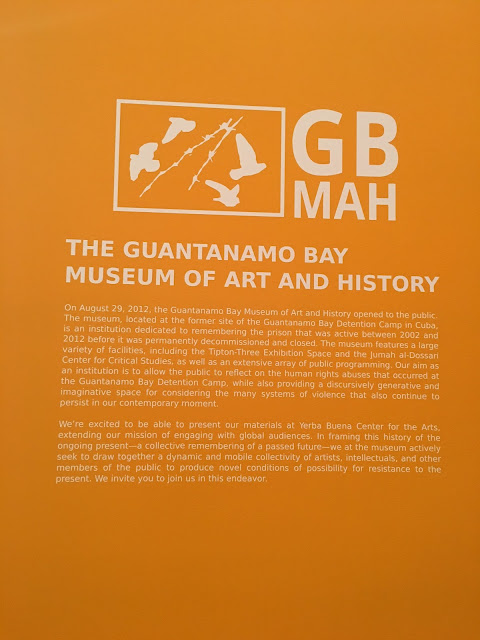 |
Information at the entrance of Take This Hammer at the YBCA. Photo: Frida Berntson, April 24, 2016.
|
Art and activism; two concepts that often go hand in hand in today’s art world, it’s hard to even think of art that isn’t in some way politically or socially loaded. So what does art activism look like today? And how has activism changed with social media, huge corporations, hashtags and profile pictures? These questions and more are covered in the exhibition Take This Hammer – Art + Media Activism from the Bay Area currently open at the Yerba Buena Center for the Arts in San Francisco.
The curator of the show, Christian L. Frock, is an independent curator, writer and educator and focuses her work on art and politics. In the very informative show brochure Deborah Cullinan, CEO, talks about how the mission of YBCA is to express culture that moves people, and that cultural movement is the essential element for change. Take This Hammer really expresses that statement; as a voice of the people.
 |
The Exhibition space of Take This
Hammer at the YBCA. Photo: Frida Berntson, April 24, 2016
|
The exhibition space was large and open, with smaller rooms and a big central room for bigger works. The first thing you see when entering the exhibition is a huge installation of posters by the graphic arts collaboration Dignidad Rebelde. Their prints are about Chicana feminism and indigenous people’s rights to confront power. Every poster declared an issue and a call for action. My favorite poster was one that declared how Oakland is occupied land and belongs to the Ohlone Native Americans. I can relate to this a little bit since I wrote a research paper about the Ohlone people in a history of California class that I took at Santa Monica College. I think anyone can relate in some way to any of the posters.
 |
Dignidad Rebelde, Selected works, 2007-15, seventy screen prints,
fifteen digital prints, and one offset print. Photo: Frida Berntson, April 24,
2016.
|
 |
Detail, Dignidad Rebelde, Selected works, 2007-15, seventy screen prints,
fifteen digital prints, and one offset print. Photo: Frida Berntson, April 24,
2016.
|
Some artworks were hard to experience, they showed how exposed Hispanic and African American people are in the Bay Area. They might be victims of possible eviction due to gentrification, or more likely to experience police brutality. The two interactive artworks by the Anti-Eviction Mapping Project showed different maps where you could acquire data about how ethnic groups have moved from different places in the city, how public space has been reduced and data about how many people of different ethnic groups are victims of police brutality by the SFPD and OPD. The artwork is simple but powerful, it is hard to experience this horrible data. One can think that the rational format makes it impersonal, but the added pictures of victims of police brutality make it both personal and real.
The whole exhibition is also about social issues of the past, present and future. In one corner of the exhibition was the innovative installation The Guantanamo Bay Museum of Art and History by The Walter Benjamin Memorial Gallery. The installation showed information about a newly opened museum at Guantanamo Bay after it was closed in 2012. You could read on the posters how the museum was dedicated to remembering the awful human rights abuses that took place there and that the institution focused on public discussion. The installation is showing a utopian present where President Obama kept his word and shut down the infamous institution. This artwork shows another present and a future that we maybe can try and accomplish.
The exhibition was very dynamic, with different types of media and showing local artists, all very positive factors. One thing that could have made the experience even better was if the show was more interactive since it was about activism.
 |
| The Walter Benjamin Memorial Gallery, The Guantanamo Bay Museum of Art and History, 2016, Mixed-media Installation. Photo: Frida Berntson, April 24, 2016 |
 |
| The Walter Benjamin Memorial Gallery, The Guantanamo Bay Museum of Art and History, 2016, Mixed-media Installation. Photo: Frida Berntson, April 24, 2016 |
Take This Hammer leaves you angry, dejected and even sad; suddenly this world of inequality opens up in front of you through art, which makes the impact even more powerful. But the exhibition also gives you strength and power to change. With artists working with this, inspiring and hoping for a better future, it really catches onto you.
 |
| Me in front of the artwork Blackout by Indira Allegra, 2015, Six-channel video, black and white, 1:30 min. Photo: Tone Persdotter, April 24, 2016 |

Loved reading this, Frida.
ReplyDelete